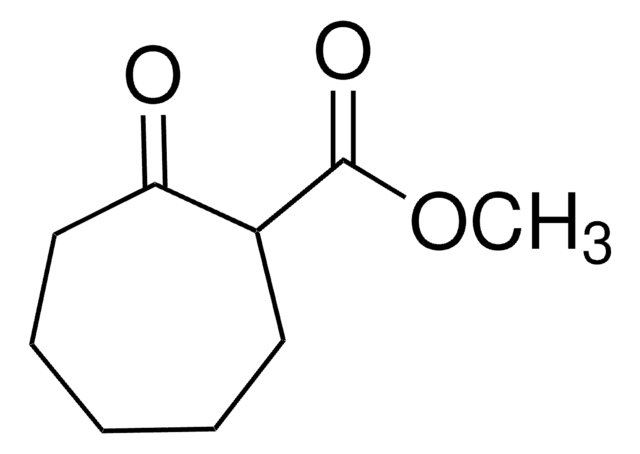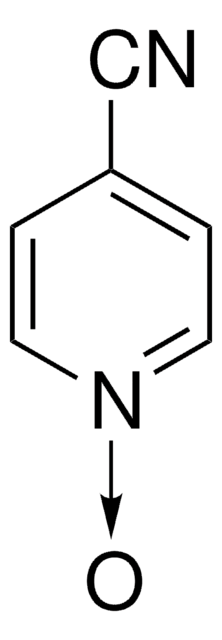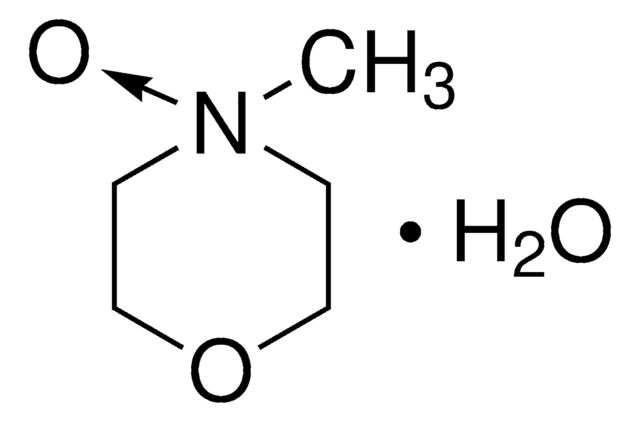349461
4-Methoxypyridine N-oxide hydrate
97%
Se connecterpour consulter vos tarifs contractuels et ceux de votre entreprise/organisme
About This Item
Formule empirique (notation de Hill) :
C6H7NO2 · xH2O
Numéro CAS:
Poids moléculaire :
125.13 (anhydrous basis)
Numéro CE :
Numéro MDL:
Code UNSPSC :
12352100
ID de substance PubChem :
Nomenclature NACRES :
NA.22
Produits recommandés
Essai
97%
Pf
82-85 °C (lit.)
Chaîne SMILES
[H]O[H].COc1cc[n+]([O-])cc1
InChI
1S/C6H7NO2.H2O/c1-9-6-2-4-7(8)5-3-6;/h2-5H,1H3;1H2
Clé InChI
ABJMARLKAXBQBC-UHFFFAOYSA-N
Description générale
4-Methoxypyridine N-oxide hydrate is a substituted pyridine N-oxide. It forms 1:1 complexes with MnCl2 and NiCl2 salts. Mechanism of reaction between 4-methoxypyridine N-oxide hydrate and bis(pinacolato) (diboron reagent) in CD3CN has been studied by NMR. It forms 1:1 complex with 2,4-dinitrophenol due to the formation of intermolecular hydrogen bond between the O-H and N-O groups.
Application
4-Methoxypyridine N-oxide hydrate may be used in chemical synthesis.
Mention d'avertissement
Warning
Mentions de danger
Conseils de prudence
Classification des risques
Eye Irrit. 2 - Skin Irrit. 2 - STOT SE 3
Organes cibles
Respiratory system
Code de la classe de stockage
11 - Combustible Solids
Classe de danger pour l'eau (WGK)
WGK 3
Point d'éclair (°F)
Not applicable
Point d'éclair (°C)
Not applicable
Équipement de protection individuelle
dust mask type N95 (US), Eyeshields, Gloves
Faites votre choix parmi les versions les plus récentes :
Déjà en possession de ce produit ?
Retrouvez la documentation relative aux produits que vous avez récemment achetés dans la Bibliothèque de documents.
1: 1 Complex of 2, 4-dinitrophenol and 4-methoxypyridine N-oxide hydrate.
Moreno-Fuquen R, et al.
Acta Crystallographica Section E, Structure Reports Online, 57(8), o712-o714 (2001)
Hari Prasad Kokatla et al.
The Journal of organic chemistry, 76(19), 7842-7848 (2011-08-05)
Facile reduction of alkylamino-, anilino-, and pyridyl-N-oxides can be achieved via the use of diboron reagents, predominantly bis(pinacolato)- and in some cases bis(catecholato)diboron [(pinB)(2) and (catB)(2), respectively]. Reductions occur upon simply mixing the amine N-oxide and the diboron reagent in
Binuclear chlorine-bridged complexes of manganese (II) and nickel (II) chlorides with pyridine N-oxides.
Karayannis NM, et al.
Inorganic Chemistry, 8(12), 2559-2562 (1969)
Notre équipe de scientifiques dispose d'une expérience dans tous les secteurs de la recherche, notamment en sciences de la vie, science des matériaux, synthèse chimique, chromatographie, analyse et dans de nombreux autres domaines..
Contacter notre Service technique









